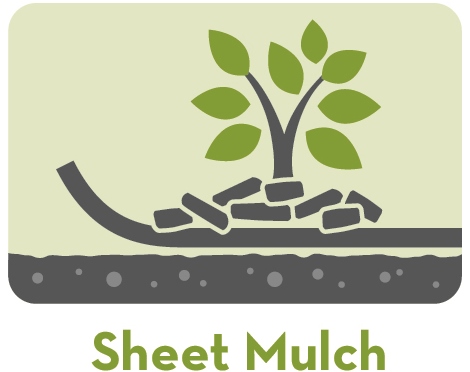Artificial Turf: Not a Sustainable Solution
StopWaste Recommends
SHEET MULCH: The Lawn to Garden website is a comprehensive guide to sheet mulching, a zero-waste, environmentally safe way to convert lawns to water-saving landscapes.
SAVE $: Go to the Lawn to Garden website to find out about rebates and DIY discounts for converting lawns to low-water, living landscapes. Most Bay Area water agencies do not give rebates for artificial turf.
BAY-FRIENDLY LAWN CARE: Keep grass looking great while reducing waste, water and chemicals:
Bay-Friendly grasscycling & lawn care brochure
Bay-Friendly lawn alternatives & groundcovers
Rodale's 6 Steps to a Healthy Organic Lawn
MORE DROUGHT TIPS: More ways to beat the drought in the garden, at home and at the table

Want to beat the drought and spruce up your property? Artificial turf is not the answer. Here are some problems with plastic grass:
- WASTE. If replacing lawn, for every acre of artificial turf installed, about 87 tons of existing grass and soil get hauled to the landfill. And when you're through with a synthetic lawn, landfilling is most often the only disposal option.
- WATER. Plastic grass needs to be cleaned periodically with water (and sometimes soaps or chemicals). And water may be needed to cool it down on hot days.
- HEAT & ENERGY. The surface of artificial turf gets very hot on sunny days, making it uncomfortable to walk on. It can also heat up the surrounding air (driving up building air conditioner use) and soil (possibly harming adjacent tree and plant roots).
- BIODIVERSITY. Artificial grass creates a lifeless environment. Living landscapes support a healthy diversity of plants, animals, and pollinators like birds, bees and butterflies.
- SOIL HEALTH. Artificial turf covers soil with a layer of plastic, depriving the soil of life. Healthy soils in living landscapes provide life-giving eco-services including cycling nutrients, improving water quality, and supporting a thriving soil ecology of microbes, worms and insects. And if a living landscape has depleted or poor quality soil, it can be brought back to life by adding compost and mulch.
- GLOBAL WARMING. Production of artificial grass is associated with significant greenhouse gas emissions. (And after it's installed, artificial turf continues to off-gas chemicals.) In contrast, in living landscapes, plants pull carbon dioxide from the atmosphere, produce oxygen and store carbon in the soil—a cycle that is essential to life on Earth.
- POLLUTION. Runoff from artificial turf can carry pollutants into surface water and groundwater. Living landscapes with healthy soils slow, spread and sink stormwater, doing a better job of absorbing and retaining water and filtering and breaking down pollutants.

